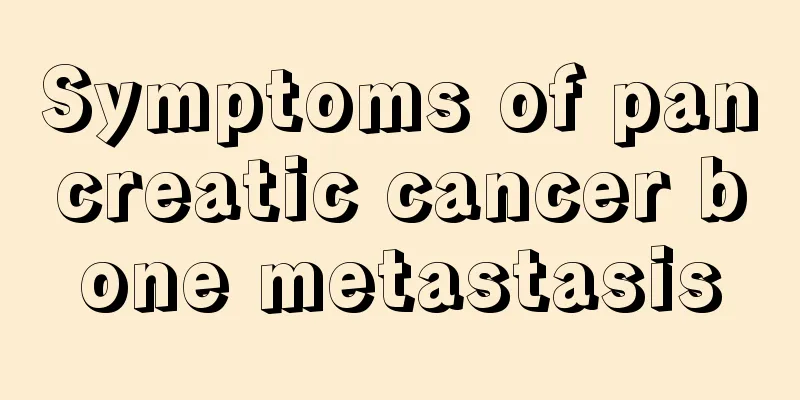What are the signs of recurrence of cerebral infarction?

|
Cerebral infarction refers to insufficient blood supply to the brain due to insufficient blood supply to the brain. It is closely related to diseases such as diabetes and obesity, and has symptoms such as sudden fainting and intellectual disability. When cerebral infarction recurs, the symptoms generally include dizziness, numbness of one side of the limbs, blurred vision, etc. Want to know what are the signs of recurrence of cerebral infarction? 1. Causes of cerebral infarction Common clinical conditions include cerebral thrombosis and cerebral embolism. The former is caused by arterial stenosis, which gradually forms a blood clot in the lumen and eventually blocks the artery. The latter is caused by blockage of arteries by abnormal substances in the bloodstream called emboli, such as emboli that break off from blood clots in the heart chambers of certain heart diseases. 2. Symptoms of cerebral infarction 1. Main clinical symptoms The clinical symptoms of cerebral infarction are complex, which are related to the site of brain damage, the size of ischemic blood vessels, the severity of ischemia, the presence or absence of other diseases before the onset of the disease, and the presence or absence of other important organ diseases. In mild cases, there may be no symptoms at all, that is, asymptomatic cerebral infarction; it may also manifest as recurrent limb paralysis or dizziness, that is, transient ischemic attack; in severe cases, there may not only be limb paralysis, but even acute coma and death. If the lesion affects the cerebral cortex, it may manifest as epileptic seizures in the acute stage of cerebrovascular disease, with the highest incidence within 1 day after the onset of the disease. Cerebrovascular disease with epilepsy as the first onset is rare. Common symptoms include: (1) Subjective symptoms include headache, dizziness, vertigo, nausea, vomiting, motor and/or sensory aphasia, and even coma. (2) Cranial nerve symptoms include staring toward the side of the lesion, central facial paralysis and tongue paralysis, and pseudobulbar palsy, such as choking when drinking water and difficulty swallowing. (3) Physical symptoms include hemiplegia or mild hemiplegia, hemisesthesia, unsteady gait, limb weakness, incontinence, etc. 2. Clinical classification of cerebral infarction site (1) Lacunar infarction: The infarct area of cerebral infarction is less than 1.5 mm, and the symptoms include: subacute onset, dizziness, unsteady gait, limb weakness, and a few patients may have choking when drinking water and difficulty swallowing; there may also be hemiplegia and hemisensory loss, and some patients have no localizing signs. (2) Medium-sized infarctions are most common in the basal ganglia, thalamus, bilateral frontal lobes, and temporal lobes. Symptoms include: sudden headache, dizziness, frequent nausea, vomiting, clear consciousness, hemiplegia or hemisensory disorder, hemianopsia, central facial paralysis and tongue paralysis, pseudobulbar paralysis, aphasia, etc. (3) Patients with large-area infarction have an acute onset and are in critical condition. They may suffer from hemianopsia, hemiplegia, hemisensory loss, or even quadriplegia, cerebral hernia, and coma. 3. Premonition of recurrence of cerebral infarction 1. Sudden headache, dizziness and drowsiness are symptoms of recurrence of cerebral infarction. After the occurrence of this symptom, it is impossible to determine whether it is a cerebral infarction and it must be considered in conjunction with other symptoms. However, to be on the safe side, in this case, it is best to go to the hospital for a brain examination immediately. 2. If facial paralysis, crooked mouth, sudden slurred speech, one or both eyes closed and swollen occur, it is basically confirmed that the stroke has relapsed and you should seek medical attention immediately. 3. Sudden weakness in the limbs and inability to lift hands and feet may also be a sign of a cerebral infarction. This is often the first symptom of a stroke. 4. If you suddenly lose your sense of balance and fall down frequently, it is basically a cerebral infarction. In this case, you should seek medical attention immediately. 5. Some stroke relapses may cause incontinence. In the early stages of cerebral infarction, urinary incontinence may occur first, and then develop into fecal incontinence. If you experience urinary incontinence, seek medical attention immediately. 6. Sudden mood swings, especially rage, followed by dullness after calming down, may also be a recurrence of cerebral infarction. |
<<: How to treat intestinal dysfunction?
>>: What causes high alkaliphilic granulocyte count?
Recommend
Which viruses does the nine-valent cervical cancer vaccine prevent?
The nine-valent cervical cancer vaccine is mainly...
How is pancreatic cancer transmitted
With the high incidence of diseases in recent yea...
The important thing for diagnosing lumbar disc herniation is
Most people will experience lower back pain, espe...
My head hurts on the right side.
Headaches are very common and complicated in dail...
Will I die if I have my teeth pulled out?
The process of tooth extraction is also quite pai...
What are the methods to correct strabismus?
Careful parents will observe in life that when th...
Distinguishing between the common cold and viral cold
Common cold Rest more and you will recover The co...
What is the reason for the black spots on the whites of the eyes
The appearance of bloodshot and yellow spots on t...
What are the symptoms of stopped development
From conception to birth, the embryo continues to...
5 chemotherapy regimens for non-Hodgkin's lymphoma
Non-Hodgkin's lymphoma does not metastasize s...
How to increase height for junior high school students
We all know that junior high school students are ...
How to treat prostate cancer
How to treat prostate cancer? Prostate cancer is ...
Is curly hair hereditary?
Nowadays, many people like to perm their hair and...
Rehabilitation methods for rheumatoid arthritis
Rheumatoid arthritis is a relatively common disea...
How to prevent lung cancer in daily life
Since the mortality rate of lung cancer ranks fir...









